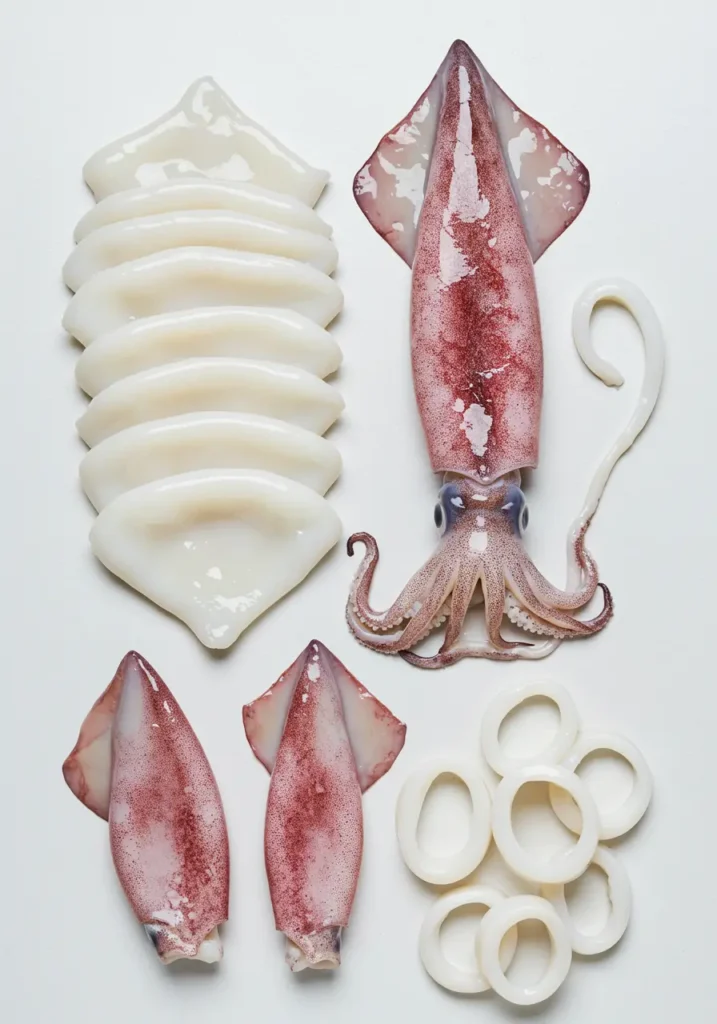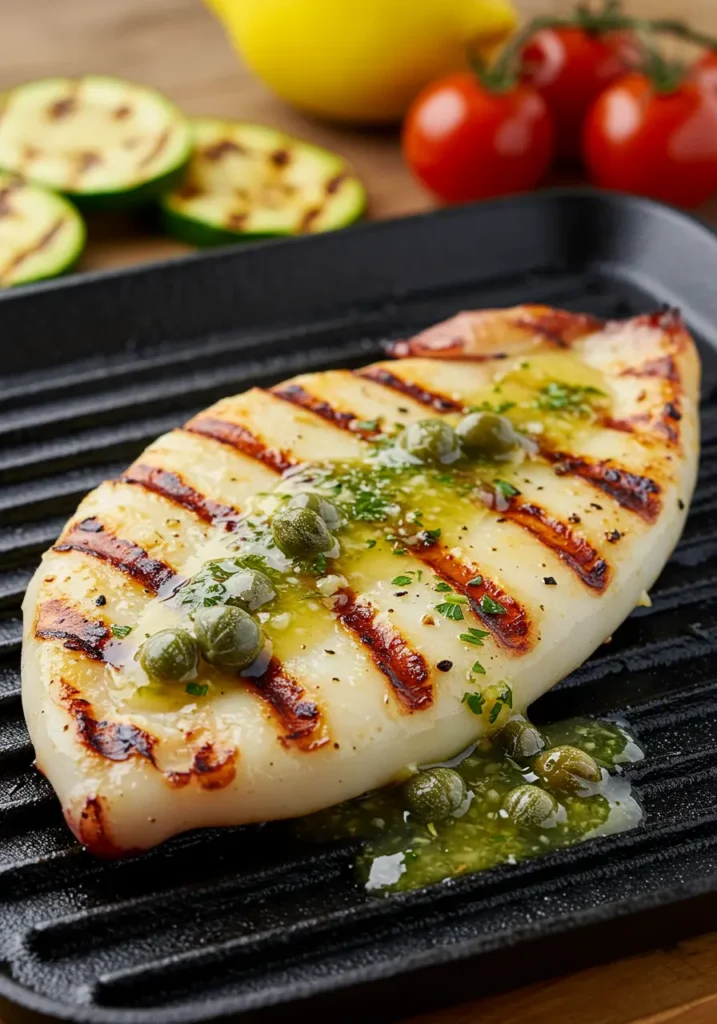How to Cook Calamari Steaks Perfectly (Tender Every Time!)

Are you tired of biting into rubbery, tough calamari steaks that remind you more of a bicycle tire than a delicious seafood dinner? You’re not alone. Many home cooks shy away from preparing calamari steaks because of this common pitfall. But here’s the good news: with the right technique and a few insider tips, you can prepare restaurant-quality calamari steaks that are tender, flavorful, and absolutely delicious.
In this comprehensive guide, I’ll walk you through everything you need to know about calamari steaks—from what they actually are to foolproof cooking methods that guarantee perfect results every time. After years of testing and perfecting techniques in both professional and home kitchens, I’ve narrowed down the essential steps that make all the difference between chewy disappointment and seafood excellence.
Table of Contents
What Are Calamari Steaks?

Unlike the more familiar calamari rings, calamari steaks are cut from the large mantle (body) of squid, typically Humboldt squid. These flat, rectangular pieces of seafood are essentially the prime cut of the squid—thicker, meatier, and offering a different culinary experience than rings or tentacles.
When shopping for calamari steaks, you’ll find them either fresh or frozen. While fresh is always wonderful if you can find it, high-quality frozen calamari steaks are widely available and work perfectly when properly thawed. Look for steaks that are ivory to pinkish-white in color, with a clean smell and firm texture. Quality matters here, as it directly impacts the tenderness of your final dish.
Why You NEED to Score Calamari Steaks (Critical Step)
If there’s one technique that separates calamari cooking novices from experts, it’s scoring. Scoring refers to making shallow crosshatch cuts on the surface of the calamari steak, and it’s absolutely essential for two reasons:
- Prevents curling: Calamari naturally curls when heated. Scoring creates a network of cuts that allows the meat to expand without curling dramatically.
- Enhances tenderness: The scoring breaks up the muscle fibers, resulting in more tender bites and allowing marinades to penetrate deeper.
To properly score calamari steaks, use a sharp knife to make shallow diagonal cuts about ¼-inch apart in one direction, then repeat in the opposite direction to create a diamond pattern. Be careful not to cut all the way through—you want shallow incisions, not to slice the steak into pieces.
Essential Prep Steps
Before you even think about heating your pan, these prep steps will set you up for success:
Thawing (For Frozen Steaks)
- Place frozen calamari steaks in the refrigerator overnight for the best results.
- If you’re short on time, seal them in a waterproof bag and submerge in cold water for about 30 minutes.
- Never use hot water or the microwave to thaw calamari, as this can partially cook the outer edges.
Patting Dry
This step is non-negotiable for a good sear. Use paper towels to thoroughly pat the calamari steaks dry on both sides. Any excess moisture will create steam in the pan, preventing proper searing and potentially leading to that dreaded rubbery texture.
Scoring
As detailed above, score both sides of the calamari steaks in a crosshatch pattern using a sharp knife.
The Key to Tender Calamari: The Cooking Time Window
Here’s the golden rule of calamari cooking that you must remember: Cook calamari either VERY quickly over high heat (60-90 seconds per side) OR simmer it very slowly for a long time (45+ minutes). There is virtually no middle ground.
Why does this matter? Calamari’s muscle fibers contract when heated. With quick cooking, they don’t have time to tighten up significantly. With very long cooking, they pass through the tough stage and begin to break down again. But that in-between time (roughly 2-20 minutes of cooking) almost always results in rubber.
For calamari steaks specifically, the quick-cooking method is generally preferred, as it preserves the steak-like qualities and delicate flavor.
Core Recipe: Pan-Seared Calamari Steaks with Garlic & Lemon

Ingredients:
- 4 calamari steaks (about 4-6 oz each)
- 3 tablespoons olive oil
- 3 cloves garlic, minced
- Juice of 1 lemon
- 2 tablespoons fresh parsley, chopped
- ½ teaspoon red pepper flakes (optional)
- Salt and freshly ground black pepper to taste
- ¼ cup dry white wine (optional)
- 2 tablespoons unsalted butter (optional, for finishing)
Equipment:
- Heavy-bottomed skillet or cast iron pan
- Sharp knife for scoring
- Tongs
- Paper towels
Instructions:
- Prepare the calamari steaks: Thaw if frozen, pat very dry with paper towels, and score both sides in a crosshatch pattern.
- Season: Lightly season both sides with salt and pepper.
- Heat the pan: Place your skillet over high heat and add the olive oil. The oil should be almost smoking before you add the calamari.
- Sear: Carefully add the calamari steaks to the hot pan (don’t overcrowd; cook in batches if necessary). Sear for 60-90 seconds on the first side until you see light golden coloration around the edges.
- Flip and add aromatics: Quickly flip the steaks and immediately add the garlic and red pepper flakes (if using) around the edges of the pan.
- Finish cooking: Cook for another 60-90 seconds on the second side. The edges should just start to curl slightly, and the calamari should feel firm but with some give when pressed.
- Optional pan sauce: If making a pan sauce, remove the calamari to a warm plate. Add white wine to the pan, scraping up any browned bits. Reduce for 30 seconds, then swirl in butter until melted.
- Serve: Plate the calamari steaks, drizzle with the lemon juice and pan sauce if made, then sprinkle with fresh parsley.
Alternative Cooking Method: Grilled Calamari Steaks
Grilling adds a wonderful smoky flavor to calamari steaks. Here’s how to do it right:

Grilled Calamari Steak Marinade:
- ¼ cup olive oil
- 2 cloves garlic, minced
- 1 tablespoon lemon zest
- 2 tablespoons fresh herbs (oregano, thyme, or rosemary work well)
- ½ teaspoon salt
- ¼ teaspoon black pepper
Grilling Instructions:
- Marinate: After scoring the calamari steaks, place them in the marinade for 15-30 minutes (not longer, as the acid can start to “cook” the calamari).
- Prep the grill: Heat your grill to high (450°F-500°F). Clean and oil the grates well.
- Grill: Place the calamari steaks on the hot grill and cook for about 1-2 minutes per side. Look for light grill marks and slight curling at the edges.
- Rest: Let the grilled calamari rest for 1 minute before serving with lemon wedges and fresh herbs.
Flavor Variations & Marinades
Mediterranean Herb
- ¼ cup olive oil
- 2 tablespoons fresh lemon juice
- 1 tablespoon chopped oregano
- 1 tablespoon chopped parsley
- 1 teaspoon minced garlic
- ½ teaspoon salt
Spicy Paprika
- 3 tablespoons olive oil
- 1 teaspoon smoked paprika
- ½ teaspoon cayenne pepper
- 1 clove garlic, minced
- 1 tablespoon red wine vinegar
- ½ teaspoon salt
Simple Soy-Ginger
- 3 tablespoons soy sauce
- 1 tablespoon grated fresh ginger
- 1 teaspoon sesame oil
- 1 tablespoon rice vinegar
- 1 teaspoon honey
Expert Tips for Success & Troubleshooting
Avoiding Rubberiness
Remember the golden rule: cook hot and fast (1-2 minutes per side) or low and slow (braising for 45+ minutes). There is no acceptable middle ground with calamari.
Getting a Good Sear
- Make sure your calamari steaks are thoroughly patted dry.
- Your pan must be very hot before adding the calamari.
- Don’t overcrowd the pan—cook in batches if necessary.
- Resist the urge to move the calamari around; let it develop a sear.
My Calamari Curled Too Much
If your calamari steaks are curling excessively, you likely didn’t score them deeply enough. The crosshatch pattern should be about ¼ of the way through the thickness. Additionally, extremely high heat can cause more dramatic curling, so adjust accordingly.
Flavor Infusion
For the best flavor, you can:
- Marinate for 15-30 minutes (not longer)
- Add aromatics to the hot oil before cooking
- Finish with fresh herbs, citrus zest, or a compound butter
Serving Suggestions

Calamari steaks pair beautifully with:
- Sides: Garlic sautéed broccolini, roasted cherry tomatoes, Mediterranean-style rice pilaf, crusty bread for soaking up the sauce
- Sauces: Lemon-garlic aioli, simple marinara, herb-infused butter, chimichurri
- Accompaniments: A fresh arugula salad with shaved parmesan, grilled lemon halves, white wine
FAQ Section
How long do you cook calamari steaks?
For tender calamari steaks, cook them quickly—about 60-90 seconds per side over high heat. Any longer risks making them tough and rubbery unless you’re using a slow-cooking method like braising.
Do you need to tenderize calamari steaks?
Physical tenderizing like scoring (making crosshatch cuts) is essential. Some cooks also use a light pounding with a meat mallet. Certain marinades with acidic ingredients like lemon juice can also help tenderize, but don’t marinate longer than 30 minutes as the acid can start “cooking” the calamari.
Can I use frozen calamari steaks?
Absolutely! Just thaw them properly first—preferably overnight in the refrigerator. Pat them very dry before cooking, as frozen seafood often releases more moisture.
What does calamari steak taste like?
Calamari steak has a mild, slightly sweet flavor with a hint of the sea. When cooked properly, the texture is tender with a pleasant firmness—similar to a very tender scallop or a delicate white fish steak.
Is calamari steak tough?
Calamari steak is only tough when overcooked. When prepared correctly using the methods in this guide, it should be tender and delightful. The key is proper scoring and adherence to cooking times.
Let’s Connect!
Did you try this calamari steak recipe? I’d love to hear how it turned out! Drop a comment below sharing your experience or any variations you tried. If you discovered any additional tips for achieving perfectly tender calamari, please share those too—we’re all learning together in the kitchen.
Have questions about working with calamari or other seafood? Ask away in the comments section, and I’ll be happy to help!
Note: This recipe was developed after extensive testing to ensure the most tender calamari steaks possible. Remember, the difference between rubbery disappointment and seafood perfection often comes down to just a minute of cooking time!
